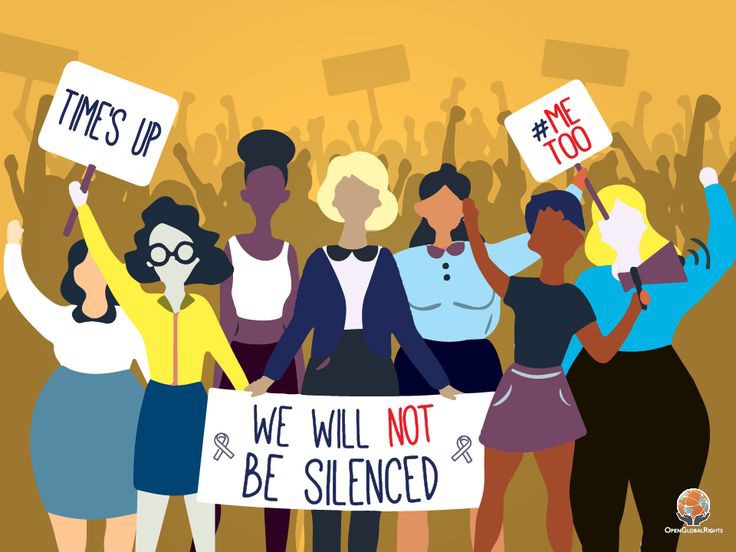What comes to your mind when you hear ‘sexual harassment?’ You probably think of a female being sexually molested, assaulted, raped, or escaping from attempted rape. That’s what most people term sexual harassment, which is accurate. However, that isn’t entirely sexual harassment.
The silly jokes that mock a woman’s body, those whispers and comments when a woman passes a crowd of males, or the indifference and habits of men in a male-dominated industry towards a lady, that crushes her self-esteem and freedom are all forms of sexual harassment.
This article will expose you to what sexual harassment is, effects of sexual harassment and how to curb it in Nigeria.
Table of Contents
Sexual Harassment of Women in Nigeria
Since the 1970s, the term sexual harassment has been debated, researched, and protested by feminists and youths. It has become a serious issue that is being captured in the media, referenced in articles and newspapers, and updated in bills of various nations.
The condition and consequences of sexual harassment continually evolve because sexual harassment is constantly being redefined as more individuals, particularly women, are victimized and traumatized. Sexual harassment occurs in the workplace, communities, schools, and home.
Unfortunately, in some cases, the harasser does not see the action as an offense; neither does the victim see the need to report such an issue. Statistics show that 1 in 3 women have been sexually harassed at workplaces, 81% have experienced harassment in verbal form, 44% have experienced physical touching, and 25% have received sexual-regarding emails and texts. Women in the restaurant and food service industry experience it the worst.
Examining the Differences Between Sexual Harassment, Assault and Abuse
Sexual harassment, sexual assault, and sexual abuse are interrelated and often wrongly intertwined. There are all concepts that involve unwanted and inappropriate sexual behavior, but they have their distinctness. Here’s an overview of the differences between them:
Sexual Harassment
Sexual harassment can be defined as unwanted and offensive sexual advances, comments, or conduct that constitute a toxic environment in workplaces, educational institutions, and other social settings. It can be in the form of verbal, non-verbal, or written; thus, it includes sexual jokes, comments, and body signs.
Sexual Assault
Sexual assault involves coercion. It is a non-consensual sexual contact or activity where one party compels the other into sexual acts against their will. This can include acts like rape, attempted rape, unwanted touching, or sexual contact without voluntary consent. Sexual assault is a criminal offense and a severe violation of a person’s bodily autonomy and sexual rights.
Sexual Abuse
Sexual abuse involves various forms of sexual mistreatment or exploitation. It can include both harassment and assault and non-consensual sexual behavior. Sexual abuse occurs in intimate relationships, families, and friends.
Examples of sexual abuse include:
- Child sexual abuse
- Sexual violence between partners
Read also: Nigerian Women in Tech: Breaking Barriers and Making Strides
Forms of Sexual Harassment
Legally, sexual harassment is inappropriate, unethical, unlawful, and perpetrators held accountable should be punished in criminal and civil court. Also, in workplaces, the employer of the perpetrators can be liable.
There are federal laws that protect employees who are victims of sexual harassment in multiple states as well. Unfortunately, many countries do not possess this law nor even regard the evil of sexual harassment, which makes women, more than ever, feel insecure and oppressed. Nigeria is one of these countries.
There are three forms of sexual harassment. These are (i) non-verbal sexual harassment, (ii) verbal sexual harassment, and (iii) physical sexual contact.
-
Non-verbal sexual harassment
Do you know that stalking, staring, winking, blocking the doorway, exposing oneself, and sending sexual messages to someone is considered sexual harassment? These are all instances of the non-verbal form, all unwanted sexual communication that neither involves physical contact nor verbal but are acts performed sexually to gain your attention.
Non-verbal sexual harassment will not necessarily give rise to a legal claim – although it is a possibility, depending on the circumstances involved. Evidence like emails and an eye witness is important to report this harassment.
-
Verbal sexual harassment
As the name implies, verbal sexual harassment involves using spoken words in a sexual manner to someone who is not interested and uncomfortable with it. In other words, if someone speaks to you in a sexually suggestive manner or comments in a sexual way that makes you uncomfortable, you are likely a victim of sexual harassment.
For a more precise understanding, here are instances of verbal sexual harassment:
- Telling sexual jokes
- Commenting on someone in a sexual manner
- Using sexual-explicit jokes
- Expressing a desire for sexual conduct
However, not everyone whose comments are sexually charged is for sexual harassment intent. For instance, sexual comments and jokes might be told to be amusing or entertaining and not to harass or offend an individual sexually. Nevertheless, there are lines that shouldn’t be crossed.
-
Physical sexual contact
When an encounter is an unwanted physical or sexual contact, it can be referred to as sexual harassment or sexual assault, depending on the severity. Examples of this form include rubbing, grabbing, hugging, kissing, patting, and unwanted touching.
Some women say that the extent to which they can not take sexual harassment is when it gets to the third form, which is physical sexual contact, but this does not apply to all women.
Some women start to feel anxious and disgusted even by nonverbal contact. So everyone must understand from the pieces to the extent of what sexual harassment is and be mindful about their language toward a woman. Women should also speak out about what jokes or comments make them uncomfortable so that their colleagues can draw the line to what kind of jokes they tell.
Read also: 10 Reasons Why Women Have Painful Menstrual Cramps.
Sexual Harassment in the Workplace
The highest percentage of sexual harassment occurs in the workplace; thus, it is a crucial aspect that must be analyzed when discussing sexual harassment. In the workplace, there are two classifications of sexual harassment; these are:
-
Quid Pro Quo sexual harassment
Quid pro quo was derived from a Latin phrase meaning “a favor for a favor” or popularly, “this for that.” This type of sexual harassment requires a superior at work offering a subordinate employee opportunities like promotion or an increase in salary in exchange for sexual advances.
This process involves convincing or, sometimes, threatening the subordinate employee to consent to sexual advances, contact, or conduct in exchange for favors at work. This is a common tactic in several Nigerian companies and industries.
Bosses trying to gain sexual pleasure in exchange for job offers has become the common ethic. Sadly, some females see it as an opportunity instead of harassment.
Similarly, in universities, quid pro quo sexual harassment is common, as it serves as an exchange of good grades for sexual advances. Although some females take this as an opportunity to excel at school or work, one cannot deny that the after-effects can lead to several emotional damages.
-
Hostile work environment
This is when women have to deal with an unhealthy work environment that makes them uncomfortable to return to work. This involves receiving offensive emails and receiving creepy comments from sexist in your job with no evidence to show forth to gain legal support.
This form usually occurs in male-dominated industries, where they tend to use sexist phrases to degrade your abilities. For instance, ‘you are too emotional, you should let men do the work’ or call you ‘sweethearts, babe, or honey’ in the workplace.
Read also: Motherhood in Nigeria: Challenges and Triumphs.
Real-life Experiences of Sexual Harassment in the Workplace
Sexual harassment occurs day in and day out at workplaces. Some women experience this but do not know they are victims because they do not understand what sexual harassment is. Others who are aware of this offense take it in and never report it because they want to keep their jobs or are trying to fit into the situation.
Below is a real-life experience of sexual harassment in workplaces that was revealed and became viral in 2020.
The Case of Kelechi Udoagwu
On June 2, 2020, a Nigerian communication consultant for tech startups, Kelechi Udoagwu, shared her story of being sexually harassed by her superior at work. The brutal rape and eventual death of an undergraduate student in the church triggered her to tweet her experiences, and her allegations went viral and progressed into a movement tagged #METOO. Her voice-out served as a wake-call to industries in Nigeria to act against sexual harassment.
The harassment happened in 2018 when she was in Meltwater Entrepreneurial School of Technology (MEST) and was to be mentored by Chief Executive of Tizeti, Kendall Ananyi. He exposed his penis, placed it on her hands, and requested she do anything she could with it. When Ugoagwu revealed this harassment on Twitter, Tizeti announced the step down of Ananyi as CEO to investigate the allegation, and Quartz Africa’s request for comment was turned down.
The allegations of Kelechi sparked a viral conversation about sexual harassment and its realities in workplaces and universities. Many women began to speak about their experiences that they had kept secret for long. However, there are still a lot of sexual harassment victims who are scared to speak up to avoid losing their jobs or being seen as a troublemaker in their workplace.
This is even sad because it extends to other recruiters when victims search for jobs elsewhere. In the case of Kelechi, she stated that she was self-employed and had nothing to be scared of during her interview with Quartz Africa. This implies that self-employment is the tool that sparks up your confidence to speak up for sexual harassment.
This draws the concern that not everyone can be self-employed in their industry; for others who are not, how do they speak up and remain protected in their industries and institutions?
Join our Whatsapp Community to participate in insightful conversations on topics about different aspects of life.
Impact of Sexual Harassment on Victims
Sexual harassment has severe consequences on victims, which can vary depending on the support system they can get, the duration of the harassment, and their emotional stability. Here are some of the common effects of sexual harassment on victims:
-
Emotional despair
Fear, anxiety, anger, shame, and various negative emotions will become an attachment to the victim. Their self-worth and self-esteem may become degraded.
-
Psychological effects
Post-traumatic stress, anxiety disorders, and depression are psychological effects that may affect victims. Most victims become hypervigilant and develop frequent flashbacks of the harassment.
-
Physical health
Chronic stress from sexual harassment can affect a victim’s physical health by causing difficulty in sleeping, headaches, and increased blood pressure.
Read also: 15 Essential Health Tips for Busy Entrepreneurs.
-
Impact on relationships
Due to the trauma victims may face, they find it difficult to build relationships or trust anyone, which makes them socially isolated.
-
Career and economic consequences
Workplace sexual harassment can negatively affect a victim’s career. They may experience difficulty at work if they fail to comply with the sexual harassment at work or if they try to speak up.
-
Sexual dysfunction
Some victims may experience sexual dysfunction or decreased exposure to activity due to their traumatic experiences.
-
Long-term trauma
Sexual harassment can leave one to face emotional trauma for years, thus, affecting such personal overall existence.
Read also: How to Overcome Childhood Trauma.
Call For Action
Sexual harassment is a perversive issue, so it is mandatory for us all to join hands in taking the next line of action to curb and cease this crime in our institutions, workplaces, and social environments.
Below are some steps and strategies that can be included in a call for action on sexual harassment:
-
Raise awareness
We should educate people about what constitutes different forms of sexual harassment and its various forms by using social media, workshops, seminars, and campaigns to spread awareness about the issue. Provision of training programs for employees, students, and community members to recognize and prevent sexual harassment should be among the goals of the Government, Employers, and NGOs.
We should also promote bystander intervention to empower witnesses to take action and the involvement of men and boys as allies in the fight against sexual harassment. Also, encouraging discussions about toxic masculinity and gender norms and supporting campaigns to raise awareness about the impact of online harassment are rewarding ways to raise awareness.
-
Encourage reporting
There should be an establishment of clear and confidential reporting mechanisms for victims to report incidents of sexual harassment. There’s also a need to ensure that there is no requital against victims and those who report.
-
Create support systems
Offering support services such as counseling and legal assistance for victims is important. We should encourage the creation of support networks within communities and workplaces.
-
Develop policies and procedures
Implement strict anti-sexual harassment policies in organizations, educational institutions, and public spaces. Clearly outline consequences for perpetrators of sexual harassment.
-
Legal framework
Advocating for stronger legal protections against sexual harassment, supporting legislative initiatives that address gaps in current laws, and encouraging collaboration between government agencies, civil society organizations, and businesses to address sexual harassment collectively should be the responsibility of everyone.
We must hold institutions and individuals accountable for their actions or lack of action in addressing sexual harassment, promote transparency in investigations and outcomes, and support and fund Research to address the prevalence, causes, and consequences of sexual harassment.
-
Cultural change
We all must promote a culture of respect, equality, and inclusivity and challenge harmful stereotypes and attitudes that perpetuate harassment.
Conclusion
This call for action is for all. All hands must be on deck to ensure that efforts to combat sexual harassment are supported over time, and issues of sexual harassment are brought to the barest minimum in Nigeria.
Do you want to receive notifications of our latest articles on lifestyle, societal issues, business, career, etc? Then, subscribe to our newsletter.
Edited by Oluwanifemi Akintomide.
About Author
Latest entries
 Business InsightsNovember 22, 2023The Basic Elements of Design to Create Catchy Visual Content Even if You’re Not a Designer
Business InsightsNovember 22, 2023The Basic Elements of Design to Create Catchy Visual Content Even if You’re Not a Designer WomenOctober 14, 2023Where’s The Line For Sexual Harassment? A Woman’s Perspective
WomenOctober 14, 2023Where’s The Line For Sexual Harassment? A Woman’s Perspective OpinionSeptember 12, 2023Social Media Influence on Nigerian Politics: Empowerment or Manipulation?
OpinionSeptember 12, 2023Social Media Influence on Nigerian Politics: Empowerment or Manipulation? Insight AfricaJuly 10, 202310 African Countries Where It Snows
Insight AfricaJuly 10, 202310 African Countries Where It Snows

